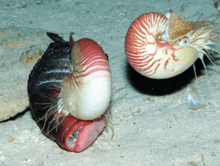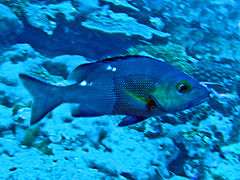Lutjanus bohar
| Lutjanus bohar | |
|---|---|
| Lutjanus bohar from French Polynesia | |
Not evaluated (IUCN 3.1) | |
| Scientific classification | |
| Kingdom: | Animalia |
| Phylum: | Chordata |
| Class: | Actinopterygii |
| Order: | Perciformes |
| Family: | Lutjanidae |
| Genus: | Lutjanus |
| Species: | L. bohar |
| Binomial name | |
| Lutjanus bohar (Forsskål, 1775) | |
| Synonyms | |
| |
Lutjanus bohar, the two-spot red snapper, is a species of snappers belonging to the Lutjanidae family. It is also known as the red bass, twinspot snapper or Bohar snapper.[3]
Description
The two-spot red snapper can reach a length of 90 cm (35 in), though most do not exceed 76 cm (30 in). The greatest recorded weight for this species is 12.5 kg (28 lb). These large reddish tropical snappers show darker fins, a rounded profile of head and a groove running from the nostrils to the eyes. They have 10 dorsal spines and 3 anal spines. Juveniles and some adults have two silvery-white spots (hence the common name) on the back close to their dorsal fins, while larger adults lose the spots and become mostly red.[4] Large adults may cause ciguatera poisoning.[5]
This species is a commercially important species and is also sought-after as a game fish.
Biology

It is a long-lived and slow-growing species which reaches maturity at 8–9 years, and the oldest recorded individual is 56.[4] These fishes are carnivorous, mostly feeding on other fishes, crustaceans and molluscs.[4]
Adult snappers often form large schools on the outer reefs or above sandy areas, mainly to form spawning aggregations. Small brownish juveniles mimic damselfishes of the genus Chromis in order to approach their preys.[5]

The chambered nautilus, Nautilus pompilius, is known to scavenge deceased snappers. A pair of nautiluses recorded feeding on a snapper at 703 metres below the surface constitutes the deepest recorded sighting of any nautilus species.
Distribution
This species is native to the Indian Ocean. It is widespreas in the Indo-Pacific from the east African coast to the western Pacific Ocean, north to the Ryukyu Islands, south to Australia.
Habitat
It is a coral reef inhabitant, being found at depths from 4 to 180 m (13 to 591 ft), though usually between 10 and 70 m (33 and 230 ft).[4]
Bibliography

- Allen, G.R., 1985. FAO Species Catalogue. Vol. 6. Snappers of the world. An annotated and illustrated catalogue of lutjanid species known to date. FAO Fish. Synop. 125(6):208 p. Rome: FAO.
- Frimodt, C., 1995. Multilingual illustrated guide to the world's commercial coldwater fish. Fishing News Books, Osney Mead, Oxford,. 215 p.
- Fenner, Robert M.: The Conscientious Marine Aquarist. Neptune City, USA: T.F.H. Publications, 2001.
- Helfman, G., B. Collette y D. Facey: The diversity of fishes. Blackwell Science, Malden, Massachusetts, USA, 1997.
- Hoese, D.F. 1986: . A M.M. Smith y P.C. Heemstra (eds.) Smiths' sea fishes. Springer-Verlag, Berlin, Germany.

- Maugé, L.A. 1986. A J. Daget, J.-P. Gosse y D.F.E. Thys van den Audenaerde (eds.) Check-list of the freshwater fishes of Africa (CLOFFA).
- Moyle, P. y J. Cech.: Fishes: An Introduction to Ichthyology, 4th. Ed., Upper Saddle River, USA: Prentice-Hall. Año 2000.
- Nelson, J.: Fishes of the World, 3rd ed.. New York: John Wiley and Sons.
- Wheeler, A.: The World Encyclopedia of Fishes, 2nd. Ed. London: Macdonald. 1985.
References
- ↑ Catalogue of life
- ↑ Biolib
- ↑ Froese, Rainer and Pauly, Daniel, eds. (2013). "Lutjanus bohar" in FishBase. December 2013 version.
- 1 2 3 4 Bray, Dianne. "Red Bass, Lutjanus bohar". Fishes of Australia. Retrieved 29 September 2014.
- 1 2 Dianne J. Bray, 2011 Red Bass, Lutjanus bohar, in Fishes of Australia